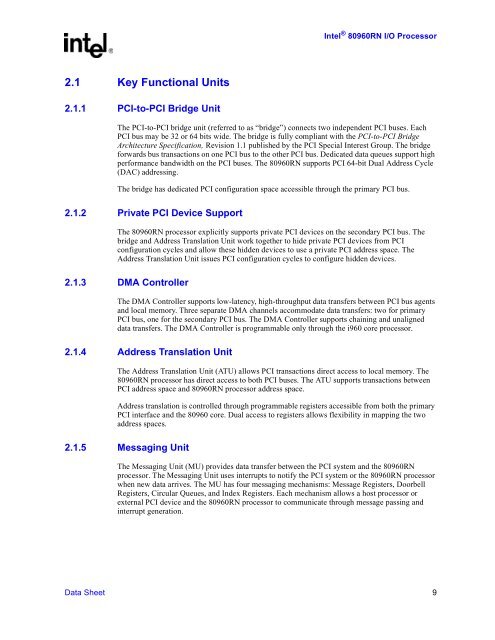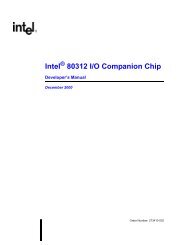IntelR 80960 RN I/O Processor Datasheet
IntelR 80960 RN I/O Processor Datasheet
IntelR 80960 RN I/O Processor Datasheet
Create successful ePaper yourself
Turn your PDF publications into a flip-book with our unique Google optimized e-Paper software.
Intel ® <strong>80960</strong><strong>RN</strong> I/O <strong>Processor</strong><br />
2.1 Key Functional Units<br />
2.1.1 PCI-to-PCI Bridge Unit<br />
The PCI-to-PCI bridge unit (referred to as “bridge”) connects two independent PCI buses. Each<br />
PCI bus may be 32 or 64 bits wide. The bridge is fully compliant with the PCI-to-PCI Bridge<br />
Architecture Specification, Revision 1.1 published by the PCI Special Interest Group. The bridge<br />
forwards bus transactions on one PCI bus to the other PCI bus. Dedicated data queues support high<br />
performance bandwidth on the PCI buses. The <strong>80960</strong><strong>RN</strong> supports PCI 64-bit Dual Address Cycle<br />
(DAC) addressing.<br />
The bridge has dedicated PCI configuration space accessible through the primary PCI bus.<br />
2.1.2 Private PCI Device Support<br />
The <strong>80960</strong><strong>RN</strong> processor explicitly supports private PCI devices on the secondary PCI bus. The<br />
bridge and Address Translation Unit work together to hide private PCI devices from PCI<br />
configuration cycles and allow these hidden devices to use a private PCI address space. The<br />
Address Translation Unit issues PCI configuration cycles to configure hidden devices.<br />
2.1.3 DMA Controller<br />
The DMA Controller supports low-latency, high-throughput data transfers between PCI bus agents<br />
and local memory. Three separate DMA channels accommodate data transfers: two for primary<br />
PCI bus, one for the secondary PCI bus. The DMA Controller supports chaining and unaligned<br />
data transfers. The DMA Controller is programmable only through the i960 core processor.<br />
2.1.4 Address Translation Unit<br />
The Address Translation Unit (ATU) allows PCI transactions direct access to local memory. The<br />
<strong>80960</strong><strong>RN</strong> processor has direct access to both PCI buses. The ATU supports transactions between<br />
PCI address space and <strong>80960</strong><strong>RN</strong> processor address space.<br />
Address translation is controlled through programmable registers accessible from both the primary<br />
PCI interface and the <strong>80960</strong> core. Dual access to registers allows flexibility in mapping the two<br />
address spaces.<br />
2.1.5 Messaging Unit<br />
The Messaging Unit (MU) provides data transfer between the PCI system and the <strong>80960</strong><strong>RN</strong><br />
processor. The Messaging Unit uses interrupts to notify the PCI system or the <strong>80960</strong><strong>RN</strong> processor<br />
when new data arrives. The MU has four messaging mechanisms: Message Registers, Doorbell<br />
Registers, Circular Queues, and Index Registers. Each mechanism allows a host processor or<br />
external PCI device and the <strong>80960</strong><strong>RN</strong> processor to communicate through message passing and<br />
interrupt generation.<br />
Data Sheet 9

















